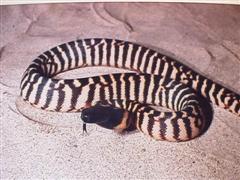Python - Blackheadead
Scientific Name: Aspidites melanocephalas
Sat, 19th April, 2025 - 5:43 am GMT
Sponsor Ads:

Alternative Name
Scientific Name: Aspidites melanocephalasBasic Info
The Black-Headed Python most commonly grows to about seven feet, with females larger than males and often reaching ten feet in length. These Pythons are light in color with darker brown or reddish bands, and the scales are smooth. The eyes are black, as is the narrow head, which is little more than an extension of the neck. Black-Headed Pythons have round noses but their upper lips lack the heat-sensing pits, which are common to many other Pythons.
Health
Breeding The Black-Headed Python reaches sexual maturity at four to five years. Male Black-Headed Pythons display their combat skills in vying for a mate, and often are seen biting each other. While incubating her eggs, the female Black-Headed Python needs more heat and will spend more time basking. Her clutch generally contains five to ten eggs. The eggs contain huge yolk reserves, which the young Black-Headed Pythons may feed from for some time before starting on solid food. They eat quite frequently and indeed may grow up to ten centimeters a month! Though it is not difficult to successfully breed the Black-Headed Python, problems with egg fertility and even with the compatibility of the breeding pair have been encountered.Habitat
Found in Australia, the Black-Headed Python is very common in its typical habitat of more humid regions on the mainlandBehavior
With a strikingly deadly appearance, the Black-Headed Python is surprisingly docile as a pet. The lovely Black-Headed Python is highly sought-after, partly because of its tolerant nature and its tendency not to bite. . It is generally nocturnal during the warmer months but may be diurnal if the weather allows. Though they can climb trees, Black-Headed Pythons prefer to stay closer to the ground. In fact, they use their rounded noses to burrow holes into the soil in which they will live. Often these Pythons are seen with only their black heads sticking out of the ground. It is thought that perhaps this allows the Black-Headed Python to wait hidden for prey to pass or to thermoregulate without having to expose its entire body. Cannibalism has been reported in this species, and so it is advisable to keep only one Black-Headed Python in an enclosure. The Black-Headed Python is a bit more docile than many other snakes, and if it feels threatened, will try to escape rather than confront the danger, slithering away and hissing rather than striking or biting.Origin
AustraliaHistory
Commonly found in the wetter areas of the Australian mainland, the Black-Headed Python inhabits the Northern third of the continent. They often live in hollow logs or grass clumps, but may be found in rocky streams or washes. In the wild, Black-Headed Pythons may die from internal parasites, lack of food, or predation by dingos. Humans are also a threat, as they often kill any snake on sight.Common Foods
The Black-Headed Python eats almost anything it can find, especially loving reptiles like frogs or monitor lizards and other, smaller snakes.Sponsor Ads:
'The project can be correct, it can be fast, or it can be on time, pick two'
Python - Blackheadead
Coded by: BGID® | ALL RIGHTS RESERVED Copyright © 2000-2025
Disclaimer | Privacy | Report Errors / Contact | Credits








 Why haven't we as a collective earth met with aliens yet?
Why haven't we as a collective earth met with aliens yet?  The Best Text Adventure You Will Ever Play! The official site:
The Best Text Adventure You Will Ever Play! The official site:  Homosexual behavior stems from the mind or genetics?
Homosexual behavior stems from the mind or genetics?  World EcoSystem - Biodiversity Changes - Who is on board and who isn
World EcoSystem - Biodiversity Changes - Who is on board and who isn  Mouthwash - Mouthrinse - Mouth Sores - Healing Infections - Gingivitis
Mouthwash - Mouthrinse - Mouth Sores - Healing Infections - Gingivitis  Treatment for Depression
Treatment for Depression  Ultra radical and violent Islamist group that even rivals Al Qaeda
Ultra radical and violent Islamist group that even rivals Al Qaeda  An idea to have teachers who want to carry guns to school undergo some level of police training will be left up to local school districts and police departments.
An idea to have teachers who want to carry guns to school undergo some level of police training will be left up to local school districts and police departments.